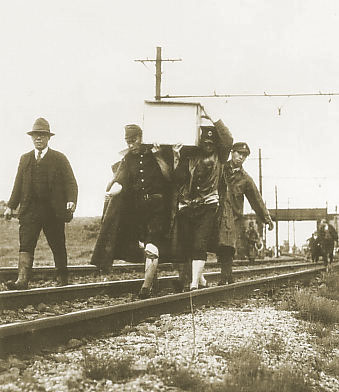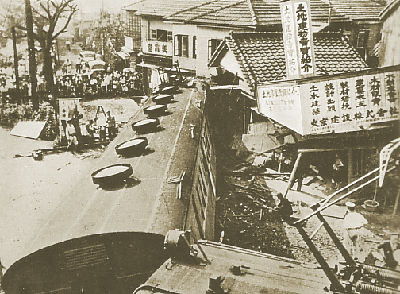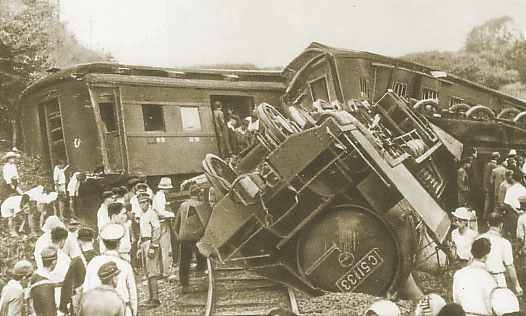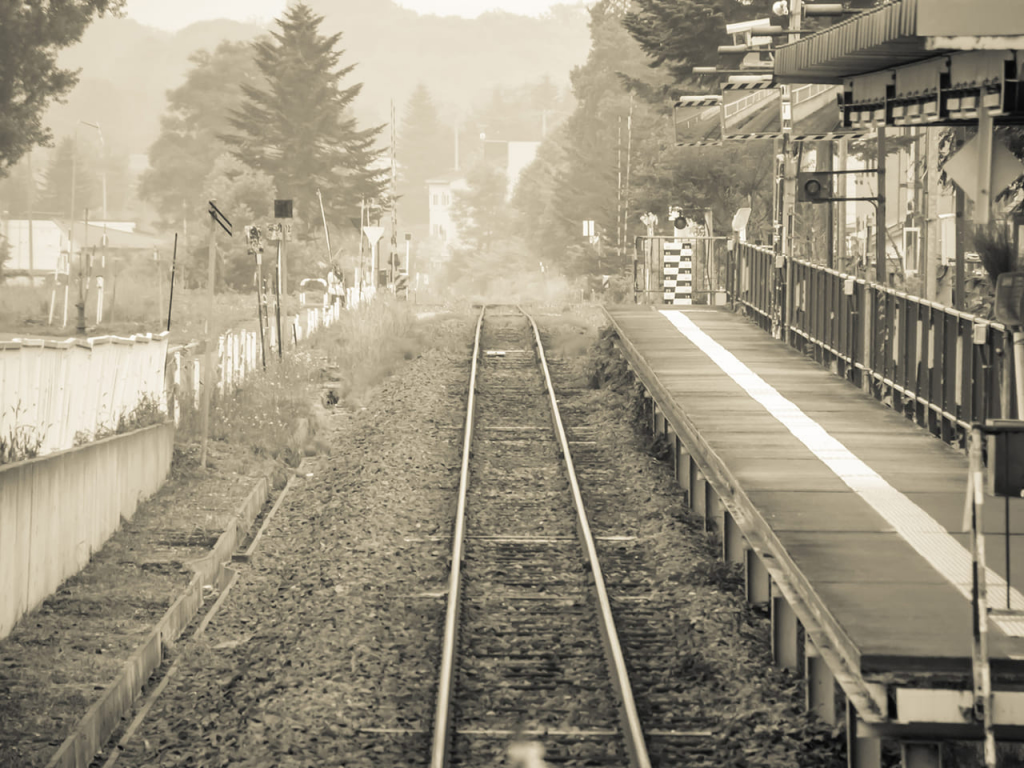In the summer of 1949 in Japan, 10 people lost their lives because of three mysterious incidents related to Japan National Railways (JNR). The unsolved death of JNR’s leading figure and two train derailments shocked the nation, sparking varying rumors as to the causes, yet almost seven decades on we’re still none the wiser.
The Background
The three episodes occurred during the Allied occupation of Japan between 1945 and 1952, a controversial period that continues to influence Japanese politics today. It’s an era British author David Peace chose to write about for his Tokyo Trilogy series. The final installment, titled Redux, about the death of JNR president Sadanori Shimoyama, is expected to be published next year.
“If one wishes to understand contemporary Japan, I believe it’s important to understand the history of the occupation, and what that experience meant for both the occupied and the occupier,” Peace tells TW. “Those six years, seven months and 28 days radically changed every aspect of life in Japan: the legacy of those changes are apparent every time you switch on the NHK news, watch the constitution deliberations in the Diet, or consider Japanese foreign policy.”
Under the direction of General Douglas MacArthur as Supreme Commander for the Allied Powers (SCAP), the first two years of the Occupation focused on demilitarizing and democratizing America’s former enemy. Ultra-nationalists were purged, land reforms were introduced and the zaibatsu (business conglomerates) were suppressed. A new constitution, with an article barring Japan from maintaining a standing army, was also adopted.
From late 1947 onwards, the focus switched towards containment. SCAP and the Democratic Liberal Party were worried that the growing economic crisis in Japan might foster a communist-led revolution, similar to what was happening in the Soviet Union and China. The fact that the Japanese Communist Party (JCP) increased its representation in the Diet from four to 35 seats in the January election exacerbated these concerns. The change in policy, known as the reverse course, resulted in public sector workers losing the right to strike, unions being afforded less bargaining power, and the zaibatsu reforming as a corporate governance system known as keiretsu.
In 1949, American banker and postwar economic adviser Joseph Dodge imposed a regime of fiscal austerity to stabilize prices and balance the budget. As well as cutting public expenditure and raising taxes, the so-called Dodge Line also called for a substantial reduction in the number of government employees. One of the first establishments to be affected was JNR. On July 4, more than 30,000 people at the rail company were laid off. Sadanori Shimoyama, the man who delivered the news, was found dead the following night.
The Shimoyama Incident
Just over a month earlier, Shimoyama had been named the first president of JNR. Known for his diligence, the Hyogo native had no choice but to follow GHQ orders regarding redundancies yet was distressed by the situation and had allegedly been sent threatening letters. The morning after releasing the list of personnel cutbacks he failed to show for an important meeting.
At 9:37am on July 5, Shimoyama got out of a car outside Nihonbashi’s Mitsukoshi department store and told his driver to wait. He was never heard from again, though an individual matching his description was spotted several times during the day. At around 12:30am on July 6, Shimoyama’s severed body was discovered on the train tracks of the Joban Line between Kita-Senju and Ayase stations in northern Tokyo.

Removal of Shimoyama’s remains from the Jōban Line. Photo: Creative Commons License, originally published in “Asahi Chronicle: the 20th century Vol.4” (Asahi Shimbun Company)
Was it homicide, or had Shimoyama jumped in front of a train due to stress? A report by medical inspector Shinnosuke Yasoshima, who examined the body at the scene, suggested the latter. The official autopsy, on the other hand, determined that the deceased had died before being hit by the train. Some believed he’d been murdered by leftist radicals out for revenge, others claimed it had been staged by American agent provocateurs wanting to discredit the communist movement. Police investigations failed to provide conclusive answers, and in 1964 the statute of limitations ran out.
“This was a pivotal moment in the occupation because, whether one believes it was an accident, murder or suicide, the consequences of his death were profound”
“This was a pivotal moment in the occupation because, whether one believes it was an accident, murder or suicide, the consequences of his death were profound,” says Peace. “It dramatically diminished left-wing political opposition and the trade union movement within Japan, while later fueling a virulent strain of anti-American feeling which lasted for decades. The legacy of these consequences – the poverty of political opposition and the weakness of trade unionism – remain to this day.”
The Mitaka Derailment
Within two weeks of Shimoyama’s death the police had another rail-related incident to investigate. On the evening of July 15, an unmanned 63 series train, with its operating handle tied down, drove into Mitaka Station, killing six people and injuring 20. It followed a second wave of JNR dismissals (around 63,000) that same week. The finger of blame was immediately pointed at members of the National Rail Workers’ Union, upset at the nationwide cutbacks. Ten people from the organization were arrested and charged with train sabotage resulting in death. All but one of them belonged to the JCP.

The Mitaka Derailment. Photo: Creative Commons License, originally published in “Pictorial Modern history: The 7th collection” (Kokusai-Bunka Johosha)
The odd man out was conductor Keisuke Takeuchi, who admitted to the crime. Yet according to the testimony of a third party he was in a communal JNR bath at the time of the incident – evidence that wasn’t presented at the trial. In 1955 Takeuchi was sentenced to death by hanging (after an original sentence of life imprisonment) due to his confession. The judges ruled that he’d planned and executed everything himself. The other defendants were all acquitted.
In a 2010 Japan Times article, lawyer Shoji Takamizawa said that Takeuchi’s confession “was driven by a sense of hopelessness amid harsh, prolonged and coercive interrogations by prosecutors.” In the past, police in Japan have been accused of physical and mental torture to get defendants to admit responsibility for a crime. Many people subsequently recant their confessions when it goes to court. Takeuchi did an about-turn, regularly pleading his innocence before dying in prison from a brain tumor in 1967. The case against him was closed, but not forgotten. His son, represented by Takamizawa, continues to push for a retrial.
The Matsukawa Derailment
The second major derailment of 1949 occurred in mid-August. Three crewmen died when a C511 steam locomotive overturned between Kanayagawa and Matsukawa stations in Fukushima Prefecture. According to accident investigators, the nuts and bolts on the track joints had been loosened, and railroad spikes had been removed. Ten union activists from JNR and another 10 from a local Toshiba factory were indicted. The coercive tactics of the police led to 20 guilty pleas with five of the accused sentenced to death. That number was reduced to four following the second trial.

The Matsukawa Derailment. Photo: Creative Commons License, originally published in “Asahi Chronicle: the 20th century Vol.4” (Asahi Shimbun Company)
Novelist Kazuo Hirotsu wrote a staunch defence of the alleged saboteurs in his publications Izumi e no Michi (The Road to Spring) and Matsukawa Saiban (The Matsukawa Trial) as well as leading their citizens’ support group. He was joined by many well-known literary figures including Nobel Prize winner Yasunari Kawabata. Their tenacious efforts brought to light the corrupt methods of the police and prosecutors who buried evidence and forced confessions. In 1961 all the defendants were acquitted at Sendai High Court. The verdict was finalized two years later.
“The Matsukawa injustices were a result of the political situation at the time,” says Masayuki Ibe, professor emeritus at Fukushima University. “Having spoken to many of the accused and their families, I can say that there’s much appreciation for the support they’ve received; however, there’s still anger at the way they were treated, particularly the harsh interrogations and the unlawfulness of the trials. It was proved that they did nothing wrong. At Fukushima University we have a room with over 100,000 documents related to the case. They must be preserved to show future generations what happened.”
Many people believe those arrested in the Mitaka and Matsukawa derailments were framed by SCAP and the government to slander the Communist Party. The other prominent view is that disgruntled union workers took retribution after losing their jobs. So, what really happened? That’s likely to remain a mystery for a long time to come.








